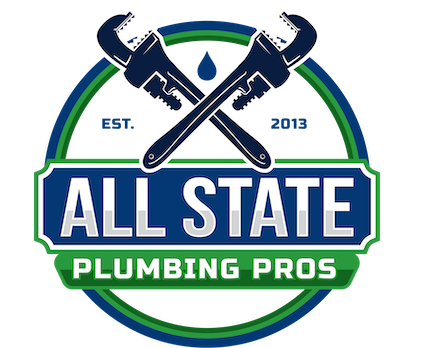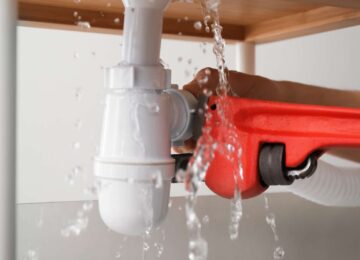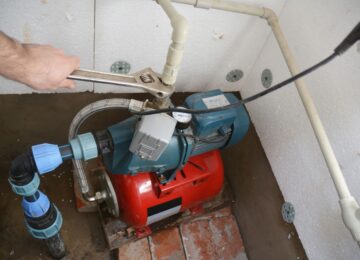Ceiling plumbing is common in many homes, especially when pipes need to be routed between floors or around structural walls. A frequent question homeowners ask is, “Do you lose shower water pressure with plumbing in ceiling?” The truth is that properly designed and maintained ceiling plumbing should not significantly affect your shower’s low water pressure.
In most cases, low shower pressure comes from issues like clogged pipes, corroded materials, or a faulty pressure regulator rather than the ceiling placement itself. By understanding how ceiling plumbing works and what truly causes water pressure loss in the water line, homeowners can separate myth from reality. With regular maintenance and the help of a licensed plumber, ceiling plumbing can provide the same reliable flow as wall- or floor-routed systems.
Factors Affecting Shower Water Pressure
Shower water pressure is determined by more than just where pipes are placed. The design, material, and condition of the plumbing system all play critical roles.
Key factors that affect water pressure include:
- Pipe size and material: Narrow pipes or older galvanized steel pipes can reduce flow and restrict water pressure.
- Clogs or corrosion: Over time, pipes may collect mineral deposits, rust, or sediment, causing blockages that lower pressure.
- Pressure regulator function: A faulty pressure regulator can cause a sudden pressure drop or maintain water flow below optimal PSI.
- Water heater performance: Malfunctioning water heaters can reduce hot water pressure, particularly if sediment has built up inside the tank.
- Municipal water supply: In many Connecticut and New York towns, fluctuations in city water supply or peak household demand can lower pressure temporarily.
When diagnosing pressure issues, it’s essential to look at the plumbing system as a whole rather than assuming the ceiling placement itself is the cause.
Ceiling Plumbing Considerations
Running pipes through the ceiling has advantages and drawbacks. Homeowners often choose this approach when routing pipes around walls or when remodeling requires alternative placement.
Ceiling plumbing can be more prone to hidden leaks, which may gradually reduce shower pressure and cause low water pressure and costly repairs if not caught early. Galvanized steel pipes in older homes are especially vulnerable to corrosion, which narrows the pipe diameter and restricts water flow. On the other hand, modern corrosion-resistant materials and proper plumbing design minimize these risks.
While ceiling placement may offer flexibility and easier access for repairs, it must be carefully planned and installed by a licensed plumber following good plumbing design. When maintained properly, ceiling plumbing should not significantly affect water pressure.
Common Causes of Low Pressure
When you notice low shower water pressure, it’s rarely the ceiling plumbing alone. More often, the issue comes down to one of several common causes that can affect any home’s water supply, which you can fix low water pressure.
Typical reasons for low pressure include:
- Clogged showerheads: Mineral buildup can block water flow at the fixture.
- Faulty regulators or valves: A defective pressure regulator, diverter valve, or mixing valve can cause pressure drops.
- Leaks or burst pipes: Even small leaks can reduce overall water pressure, especially in ceiling lines where leaks are harder to detect.
- Sediment buildup in the water heater: This reduces flow and can cause uneven hot water pressure.
- Closed or partially shut valves: A supply valve that isn’t fully open can restrict water flow to the shower.
Identifying which of these problems is present is the first step toward restoring consistent water flow.
Troubleshooting Low Shower Water Pressure
If your shower feels weak or inconsistent, a step-by-step troubleshooting process can help narrow down the cause.
Start by cleaning or replacing the showerhead, since mineral deposits often restrict flow. Next, inspect visible pipes for leaks or corrosion, and check the water pressure regulator to ensure it’s adjusted correctly. If you rely on a water heater, confirm that it’s operating efficiently and isn’t clogged with sediment.
Steps to troubleshoot include:
- Clean the showerhead with a vinegar solution or replace it if clogged.
- Check for pipe leaks or blockages in the ceiling or walls.
- Inspect the pressure regulator and adjust or replace as needed.
- Test the water heater and flush it if sediment is present.
- Check the municipal water supply during different times of day to see if demand is reducing the flow.
If these steps don’t resolve the problem, contacting a professional plumber ensures that hidden leaks, corroded pipes, or larger system issues are correctly addressed.
Maintaining Optimal Water Pressure
Keeping your home’s water pressure steady requires routine care. Even small maintenance tasks can prevent pressure loss and extend the life of your plumbing system.
Some important practices include:
- Regular pipe inspections: Look for leaks, corrosion, or blockages that may reduce water pressure.
- Use a water pressure regulator: This keeps pressure consistent and prevents damage to fixtures.
- Clean or replace showerheads: Regular cleaning removes mineral deposits that restrict flow.
- Install water treatment systems: A softener or filter reduces sediment buildup inside pipes and showerheads.
A consistent maintenance schedule helps homeowners avoid the frustration of sudden low pressure and protects against hidden ceiling plumbing issues.
Enhancing Shower Water Experience
Beyond maintenance, there are upgrades homeowners can consider to improve shower pressure and overall comfort.
Switching to a low-flow showerhead may sound counterintuitive, but many models conserve water while optimizing flow rate. Upgrading to a modern, efficient water heater can also help maintain pressure, especially in multi-story homes.
Additional solutions include:
- Installing a shower pump or pressure booster for homes with persistent low water flow.
- Cleaning fixtures with a vinegar solution to remove mineral buildup.
- Considering a tankless water heater for a consistent hot water supply.
These enhancements not only improve your shower experience but can also reduce water waste and energy bills.
Plumbing System Components
Understanding the main parts of your plumbing system helps pinpoint where pressure issues may occur. Key components include:
- Water heater: Supplies hot water; sediment buildup reduces flow.
- Pressure regulator: Controls water entering the home and prevents pressure spikes.
- Shower and diverter valves: Distribute water between fixtures; faulty valves can reduce pressure.
- Supply lines and shut-off valves: If closed or corroded, they restrict water flow.
- Outdoor faucets (hose bibs): Leaks here can reduce household pressure.
When one of these parts fails, the entire home may experience pressure problems.
Preventing Water Pressure Loss
The best way to avoid sudden water pressure problems is proactive prevention. This means combining smart installation with consistent upkeep.
Prevention strategies include:
- Scheduling regular inspections with a licensed plumber.
- Use high-quality, corrosion-resistant pipes for new installations.
- Avoid excessive pipe bends or long runs when designing ceiling plumbing.
- Installing a pressure-reducing valve to stabilize household pressure.
- Adding a whole-house water filter to protect against sediment buildup.
These steps help ensure your shower pressure remains consistent regardless of where your pipes are routed.
Water Pressure and Ceiling Plumbing
So, do you lose shower water pressure with plumbing in the ceiling? The answer is: not necessarily. Properly designed ceiling plumbing can deliver the same performance as wall-routed systems when pipe size, material, and layout are optimized.
Corrosion-resistant materials, correct pipe sizing, and regular inspections help ceiling plumbing maintain strong, reliable water pressure. A professional plumber can evaluate any concerns, identify hidden leaks, and restore pressure if ceiling placement contributes to problems.
Conclusion
Ceiling plumbing itself does not automatically reduce shower water pressure. Instead, issues like corroded pipes, clogged shower heads, faulty regulators, and sediment buildup are more likely culprits. With proper installation, regular maintenance, and the support of a licensed plumber, homeowners in Connecticut and New York can enjoy consistent, reliable water pressure even when pipes are routed through the ceiling.
That said, if you’re still dealing with low shower water pressure or aren’t sure whether ceiling plumbing is the culprit, it’s best to call in a licensed professional. At All State Plumbing Pros, we’re available 24/7 to help homeowners and businesses in Connecticut and New York restore strong, reliable water flow. Whether you need a quick repair, water heater service, or a full inspection of your plumbing system, contact us today for fast, dependable service you can trust.
FAQs
What would cause water pressure to drop in a shower?
Low shower water pressure is usually caused by clogged showerheads, leaking pipes, sediment buildup in the water heater, or a faulty pressure regulator affecting both hot and cold water. Sometimes, municipal supply fluctuations or closed valves within the home’s plumbing system can also contribute.
How to increase upstairs shower water pressure?
To improve upstairs pressure, start by cleaning or replacing the showerhead, checking valves to ensure they’re open, and inspecting pipes for leaks or clogs to meet the water demand. In multi-level homes, installing a pressure booster pump or adjusting the regulator can significantly improve water flow.
Why is my shower pressure low, but the sink is fine?
If your shower has low pressure but your sink doesn’t, the problem often lies in the showerhead, diverter valve, or mixing valve. Mineral deposits may clog the showerhead, or a faulty valve may restrict water flow only at that fixture, leaving the sink unaffected.
Why does my shower head decrease water pressure?
Showerheads can decrease water pressure due to mineral buildup, clogged flow restrictors, or worn-out components. Cleaning with a vinegar solution or replacing the showerhead usually restores normal flow. If the problem persists, there may be deeper plumbing issues affecting pressure.

![Do You Lose Shower Water Pressure with Plumbing in Ceiling? Ceiling plumbing is common in many homes, especially when pipes need to be routed between floors or around structural walls. A frequent question homeowners ask is, “Do you lose shower water pressure with plumbing in ceiling?” The truth is that properly designed and maintained ceiling plumbing should not significantly affect your shower’s low water pressure. […]](https://allstateplumbingct.com/wp-content/uploads/2025/09/do-you-lose-shower-water-pressure-with-plumbing-in-ceiling-750x420.jpg)



Leave a Reply